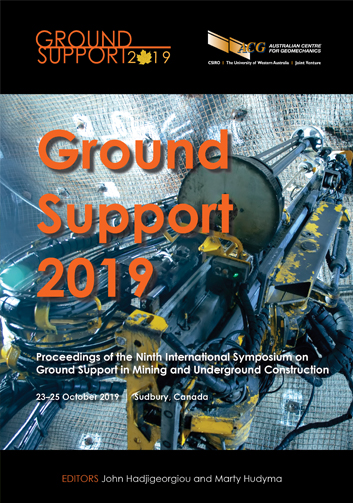Developments in stiff ground support in deep potash operations at the Vanscoy Mine

|
Authors: Coleman, TJ; Neely, DD |
DOI https://doi.org/10.36487/ACG_rep/1925_37_Coleman
Cite As:
Coleman, TJ & Neely, DD 2019, 'Developments in stiff ground support in deep potash operations at the Vanscoy Mine', in J Hadjigeorgiou & M Hudyma (eds), Ground Support 2019: Proceedings of the Ninth International Symposium on Ground Support in Mining and Underground Construction, Australian Centre for Geomechanics, Perth, pp. 519-532, https://doi.org/10.36487/ACG_rep/1925_37_Coleman
Abstract:
This paper presents a case study of the development of ground support practices at Nutrien’s Vanscoy potash mine, the deepest (>1,100 m) conventional evaporite mine in North America. The majority of the underground excavations at Saskatchewan potash mines are unsupported and rely upon the principle of stress control to manage ground conditions. Adverse ground conditions are typically addressed in three ways: changing mining horizon to avoid disturbed ground, cutting down of bad ground, or installation of ground support. The two former approaches often result in extended interruptions to production whereas installation of ground support allows access to be maintained and production to continue. The timedependant creep properties of the evaporites led to the historical approach of using a soft ground support system to accommodate the large deformations typically seen. The softness of the ground support system at potash operations was typically achieved by utilising point anchored mechanical rockbolts, partial encapsulation of resin rebar bolts, or by introducing a softer element in to a fully encapsulated resin rebar support element, at Vanscoy a wood washer was used. The experience of one of the authors with the improvement of excavation stability following the introduction of stiff resin encapsulated AT rockbolts for secondary ground support at the deep (>1,300 m) Boulby potash mine in the UK led to initial instrumented trials at the Vanscoy Mine. Multipoint magnesonic extensometers were introduced to the mine to provide detailed measurement of back deformation to assess the impact of increasing the ground support stiffness on back behaviour. The magnesonic extensometers comprise of 20 magnetic reference anchors installed over a depth of 7 m allowing precise high resolution measurement of back deformation. The introduction of magnesonic extensometers to monitor the influence of stiffening the ground support system proved invaluable in understanding the mechanism of ground support/rock mass interaction in the immediate stratified back of development and production excavations. The Vanscoy Mine has adopted stiffer ground support practices and continues to explore other ground support technologies in the pursuit of safe optimised ground support practices.
Keywords: potash, ground support, Vanscoy Mine, evaporite mine
References:
Baar, CA 1971, ‘Applied rock mechanics in deep potash mines – creep and stress redistribution upon mining deep salt and potash beds’, Saskatchewan Research Council Report E 71-2.
Mackintosh, AD 1975, ‘Applied rock mechanics: the development of safe travelways at the Cominco Potash Mine’, Proceedings of the Tenth Canadian Rock Mechanics Symposium, Queen’s University, Kingston, pp. 69–95.
Mraz, DZF 1972, ‘The theory of flow and its practical application for pillar designs in deep potash mines’, Western Miner, April 1972, pp. 22–26.
Mraz, DZF 1973, ‘Behavior of rooms and pillars in deep potash mines’, Canadian Institute of Mining, Metallurgy and Petroleum Transactions, vol. 76, pp. 138–143.
Neely, DD 2014, Failure mechanism of resin anchored rebar in potash, MSc Thesis, Dept of Civil and Geological Engineering, University of Saskatoon, Saskatoon.
Prugger, FF 1979, ‘The operation of the Cominco Potash Mine with special consideration of some principles of applied rock mechanics for strata control’, Proceedings of the Fifth International Symposium on Salt, Hamburg, West Germany,
pp. 319–332.
Serata, S 1972, ‘The Serata stress control method of stabilizing underground openings’, Proceedings of Seventh Canadian Rock Mechanics Symposium, Department of Energy, Mines and Resources, Ottawa, pp. 99–118.
© Copyright 2025, Australian Centre for Geomechanics (ACG), The University of Western Australia. All rights reserved.
View copyright/legal information
Please direct any queries or error reports to repository-acg@uwa.edu.au
View copyright/legal information
Please direct any queries or error reports to repository-acg@uwa.edu.au